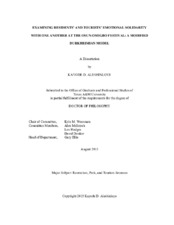| dc.description.abstract | Festivals provide an avenue for communities to showcase their cultural identity for outsiders while at the same time allowing tourists to interact with residents in developing potential relationships. Cultural festivals provide a platform for residents and tourists to interact in an unscripted manner within a confined place and time, ensuring a cultural exchange, social interaction and display of social identity. Researchers have generally focused more on economic impacts and marketing of cultural festivals, placing less emphasis on its social impacts on the festival community, prompting call for more research on socio-cultural impacts of festivals and events. The theoretical framework of Durkheims’ emotional solidarity offers a lens through which to examine not only the social impacts of festivals and events but also the relationship that results from resident and tourist interaction.
The present study modified and employed the theoretical framework of Durkheims’ emotional solidarity in examining the relationship between residents living adjacent to and tourists attending the Osun Osogbo Festival. In the tourism setting, some degree of emotional solidarity will occur as residents and tourists interact with each other behaviorally and through shared beliefs. In expanding the emotional solidarity model, place attachment, motivation and perceived safety was added to the antecedent constructs of shared beliefs, shared behavior, and interaction to predict emotional solidarity residents and tourists have for one another.
Data for this study were collected in the ancient city of Osogbo, State of Osun, Nigeria in August, 2014 during the annual celebration of the Osun Osogbo Festival. Samples were drawn from the residents of Osogbo and tourists to the annual Osun Osogbo Festival (OOF) during the 12-day event. The study provides empirical evidence in support of placement attachment through its two factors, place identity and place dependence, predicting the three factors of the ESS, welcoming nature, emotional closeness, and sympathetic understanding, within the residents’ model.
The findings of the study have theoretical and practical implications. Despite mixed findings and modest variance explained in emotional solidarity, the six predictor constructs do provide valuable theoretical insight surrounding solidarity, especially its applicability within a global context involving diverse cultures. For practice, the study offers support and some guidance for festival organizers and destination marketing managers in promoting peaceful co-existence between the residents and tourists in forging emotional bonds. It also gives direction in making the festival more internationally known and accepted. | en |


